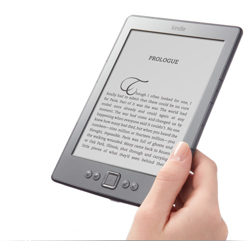
How do the Kindle and other e-readers fit into our lives and culture?
Much has been written about how e-readers are changing the face of publishing, inviting anyone in the world to become a writer and self-publish their books, and making it extremely convenient to possess a library of books wherever you go. I want to discuss something else.
How do e-readers alter our perception of a book, the real physicality of the book?
- From a writer's perspective, the first concern is the perception of value. We find it hard to assign value to a digital file. After all, we can download sizable books into our Kindle, even entire series, in under a minute. That little percentage bar along the bottom of the screen makes it difficult to appreciate the size, the physical weight, of the book we are reading, were it in paper form. No wonder there is an expectation for e-books to be sub-$5 or even 99c. It's just a file, right? Humans assign value to physical size – big cars, big houses, big TV's. We work in tangibles, not electronic bits.
- E-books are not a work of art, and by that I mean physically of course, since the artistic value is the content itself. Remember thumbing through that old book, printed on extravagant paper with an embossed leather cover, cloth bookmark, colour illustrations? Feel the weight, smell the pages. Not any more. Just a cold, clinical screen. It won't mean that collector books become extinct of course, in the same way that CD's and iTunes never halted the healthy market of vinyl. Didn't we also complain about losing the gorgeous artwork of vinyl sleeves when we went to iTunes?
- What of our libraries? My wife and I have an entire room dedicated to shelves and shelves of books, hardcover and paperback. We both love collecting books and never use public libraries. Now, apart from the odd special book, everything goes into our Kindles. We are already considering culling the physical library, especially the paperbacks, to free up space. It is likely that when we move house, many of those books won't travel with us. Practical and convenient, but somehow sad and inevitable.
- Our houses will look much different in 5 or 10 years, when we do not have bookshelves throughout our homes. This dramatically alters the impression that we form when we enter a house. No longer can we immediately identify a person as a reader, as a book lover. We cannot browse their shelves and categorize our hosts as fans of murder mysteries, or science fiction, or Doyle, Poe, Dickins. We could be having dinner with an expert on Norse mythology and never know that they have 500 books on that subject, but they are all hidden away on their Kindle.
- What of lending books? Most e-readers support the concept of limited lending, typically the transfer of a book file from one device to another. Publishers usually lock out this functionality in an effort to enforce their digital rights. Electronic files can be copied rather than lent, a possible loss of income for the publisher, and author. Try photocopying an entire hardcover. But this is our loss. One of the greatest favours we can do to others, especially children, is to lend them a book, get them interested in reading or expanding their horizons. Isn't it great to drop off used books to a hospital or school, or donate them for the under-privileged? How are we going to manage that in the digital age?
- Physical books are a conversation starter, even a friendship starter. Who hasn't climbed into someone's car, or stepped into their house and seen an interesting book lying there. “Oh, you're reading that, what did you think of the ending?” Or you see someone on a train, or plane, or in a doctor's office, reading a particular book. “Everyone seems to be reading that lately. What's it like?” In comparison, the e-reader is a private reading affair. Are they reading Harlequin or Shakespeare? Or the WSJ?
- Liberally marking up a book with yellow highlighter, dog-earing pages, or using sticky notes are all convenient and rapid forms of content identification. These concepts exist in electronic forms too, but aren't immediately obvious, and usually involve some kind of text search. While most e-readers today are monochrome, we totally lose the ability to categorize content by coloured notes; red for material I want to include in my article/book, yellow for background material, blue for erroneous material, etc.
These are just some of the issues that we face by widely accepting e-books. I'm certainly not against any form of digital material. It can be extremely convenient, portable and is definitely the way of the future. But, the human brain has evolved to react to physical objects, with analog concepts like thickness of the book, a dog-eared page, the instantly-recognizable book cover on a shelf. We will eventually develop digital equivalents, and I have no doubt that they will prove even more useful. Imagine walking into someone's house: Your smart phone/device connects via wifi to your host's media server or e-reader, and performs a non-invasive category match against their book collection. Your smartphone beeps. Its screen tells you that your host is a Lovecraft fan, just like you are, but that they don't appear to possess books by Poe. There's a conversation starter.
I believe that current-day e-readers are an alpha product, a prototype of the world to come. This is a transitionary period, in which we will temporarily suffer the loss of our physical books, before invention and technology makes the digital form so superior that it would be like comparing a modern hardcover to an ancient stone tablet.
What other ways do e-readers change our relationship with the physical book? Please comment!

